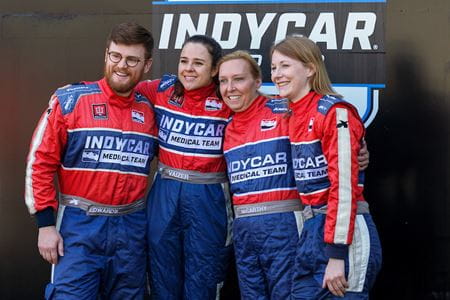As Leonard Edwards, MD, MBA, walked to pit row during a practice day for the 108th running of the Indianapolis 500, a group of excited elementary students in matching red field trip shirts swarmed him, clamoring for his autograph. He smiled and obliged, not wanting to tell them he isn’t a driver.
Edwards looked the part — dressed in a fire suit with “Firestone” across the shoulders and wearing a white helmet with a red racing stripe down the middle — but a closer inspection of the emblems on his suit would reveal his designation as a member of the INDYCAR Medical Team.
For over 100 years, Indiana University Health and its predecessors have partnered with the Indianapolis Motor Speedway to provide medical services to drivers, teams and fans. But there had never been a formal education program for physicians in motorsports medicine — until now. Edwards is the third person ever to train in the Motorsports Medicine Fellowship program launched by Indiana University School of Medicine in 2020.
It’s the only program of its kind in the world.
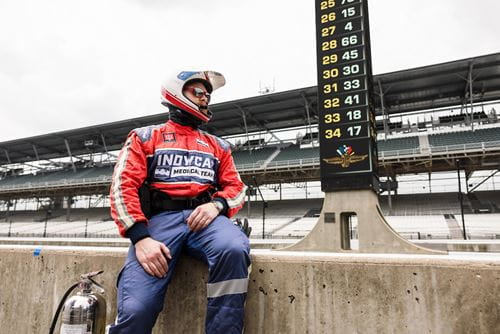
“I didn't know what to expect coming into the fellowship,” he said. “It has exceeded my wildest dreams. From the first day I started on the safety team — sitting next to the experts in motorsports medicine, them teaching me everything they know, responding to some pretty bad crashes on my first day, just being thrown in, and now, all the way to the Indy 500 — it’s been an incredible ride.
“I think I've gained probably 10 years or more of motorsports knowledge and experience just in the 10 months that I've been here.”
Each morning, Edwards wakes before the dawn, grabs his breakfast and coffee, suits up, and heads to the Brickyard before the racetrack comes alive.
“I show up in my suit and people are like, ‘Do you sleep in that thing?’” Edwards just laughs and smiles. “I say, ‘Maybe. Why? Would that be so bad?’ I pinch myself every day. This is a dream come true — the best job in the world.”
Caring for the world’s fastest moving athletes
There’s nothing quite like the month of May at the Indianapolis Motor Speedway (IMS). And nothing equal to the immersive training opportunities it provides. In addition to the year-long fellowship program, IU School of Medicine offers a May rotation for emergency medicine residents from IU and other medical schools across the nation.
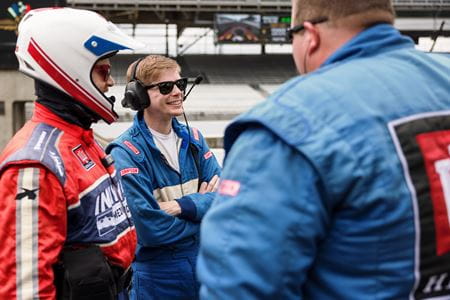 “It’s a once-in-a-lifetime opportunity to be able to do this and learn from some of the best people in the field,” said Justin Smith, MD, a second-year resident at IU, as he stood watch from pit row, ready to aid racing team members with smashed fingers, burns or other types of pit injuries.
“It’s a once-in-a-lifetime opportunity to be able to do this and learn from some of the best people in the field,” said Justin Smith, MD, a second-year resident at IU, as he stood watch from pit row, ready to aid racing team members with smashed fingers, burns or other types of pit injuries.
Third-year resident Austin Daly, DO, started his day with a high-speed ride around the oval in the medical response vehicle, known as the 1200 car, along with Edwards and last year’s fellow, Melissa McCarthy, MD, who is now a safety consultant with INDYCAR and an assistant professor of emergency medicine practice at IU School of Medicine.
Each day, the INDYCAR safety team is responsible for checking the IMS track and clearing the surface of any debris before racing begins. For Edwards, that meant incurring the wrath of a hungry hawk who started divebombing him one morning as he disposed of some roadkill.
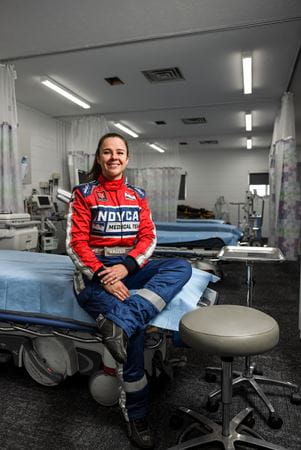 Every day is different at the Brickyard. And there is no day quite like race day. On May 26, IMS will host more than 320,000 people, making it Indiana’s “second largest city” for the day.
Every day is different at the Brickyard. And there is no day quite like race day. On May 26, IMS will host more than 320,000 people, making it Indiana’s “second largest city” for the day.
Julia Vaizer, MD, leads the massive, multi-organizational medical operations as medical director for IMS and INDYCAR. She also leads IU’s Motorsports Medicine Fellowship. As the program’s first graduate, Vaizer was the logical choice to succeed her mentor, program founder Geoffrey Billows, MD, when he retired in 2022 after 30 years with INDYCAR.
Vaizer now directs a team of more than 200 medical professionals — physicians, nurses, EMTs and others — who treat on-track injuries along with all the other medical needs that arise within the nearly 560-acre oval.
“Diabetic emergencies, strokes, heart attacks, overheating and overindulgences — all the things that you would typically see in an emergency room in a large city, we see them here,” Vaizer said.
The 18-bed Infield Care Center has a private side for injured drivers and a public side which includes a separate area for critically ill patients to receive lifesaving care before being transferred to nearby IU Health Methodist Hospital. There’s also an overflow tent for minor injuries and a dedicated medical station to serve the roughly 21,000 concertgoers in the Snake Pit. That area is led by Daniel O’Donnell, MD, and staffed by IU Health.
Vaizer calls Angela Fiege, MD, deputy medical director for INDYCAR, “my No. 1.” With two decades of experience in motorsports medicine, Fiege helped train Vaizer. She is the former medical director for NASCAR and is now medical director for INDYCAR’s developmental racing series, INDY NXT by Firestone.
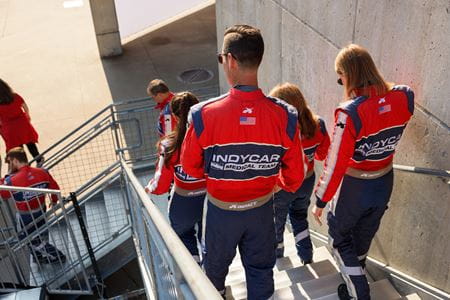
Other physicians on the core medical team include IU School of Medicine faculty Debra Rusk, MD, and James Nossett, MD.
IU neurologist Bert Vargas, MD, is the newest addition to the medical team — initially recruited by Fiege for NASCAR in 2017 as the auto racing industry began to realize the importance of including specialists to assess and treat concussions. He now enjoys working at IMS alongside IU School of Medicine trainees.
“This is a fast-paced environment, literally, as you’re dealing with athletes that are moving faster than any other athlete on the planet,” Vargas said. “And then figuratively, this field is moving so fast. It’s a testament to the vision of Dr. Vaizer and Dr. Fiege and others who have the passion and experience to teach fellows and residents how to do this job well.”
Driver rescues and safety development
On race day, Edwards will be stationed in the 1200 car with Billows, ready to respond to crashes within seconds. The team trains for every possibility — flames, entrapment, unconscious drivers and more.
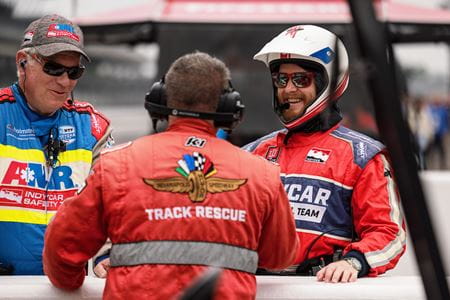 Edwards’ skills were tested the very first day he suited up as a motorsports medicine fellow. On July 1, 2023, INDYCAR driver Simon Pagenaud experienced brake failure resulting in a season-ending crash at the Mid-Ohio Sports Car Course. Edwards was first on the scene.
Edwards’ skills were tested the very first day he suited up as a motorsports medicine fellow. On July 1, 2023, INDYCAR driver Simon Pagenaud experienced brake failure resulting in a season-ending crash at the Mid-Ohio Sports Car Course. Edwards was first on the scene.
After witnessing Pagenaud’s violent barrel roll — slamming him into a tire barrier and landing him upside down — anyone watching the event next saw Edwards sprinting to the crash site. He slid through the gravel to get to Pagenaud like a pro baseball player sliding into home plate.
“Through all that adrenaline, I’m trying to calm my brain, thinking about all the steps I need to take if I get there and I ask him, ‘Hey, are you OK, Simon?’ and I don't hear anything,” Edwards recalled.
Thankfully, Pagenaud was alert, and Edwards joined seven members of the safety team in lifting the car so Pagenaud could be pulled from the wreckage in under two minutes.
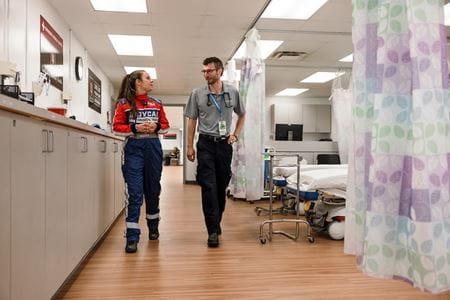 Vaizer didn’t see the crash but was quickly on the scene to escort Pagenaud off track for medical evaluation. She immediately noticed that Edwards’ new, personalized fire suit was covered in dirt from the chest down.
Vaizer didn’t see the crash but was quickly on the scene to escort Pagenaud off track for medical evaluation. She immediately noticed that Edwards’ new, personalized fire suit was covered in dirt from the chest down.
“I kind of looked at him like, ‘We just gave you this brand-new fire suit and you’re all dirty,’ but when I saw the video of what he did, I was like, ‘Oh my goodness!’” she said. “It was very impressive.”
Morgan Sweere, MD, an emergency medicine resident visiting from the University of Florida—Jacksonville, helped flip a car to rescue a driver who crashed during practice this month at IMS.
“It was the driver’s first rollover, so he was a little shaken,” she said. “The 1200 car took him to the Infield Care Center, and he was OK.”
Sweere grew up in the world of dirt racing and said rotating in Indianapolis “has been the best month of my life.” As a medical professional, the training opportunity is unparalleled. As a fan, Sweere is rooting for rookie Kyle Larson, who has a dirt racing team she follows.
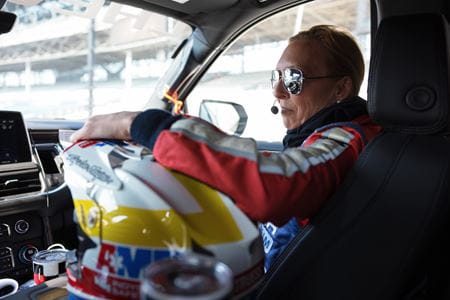 The May rotation is somewhat of a month-long audition for residents interested in applying for IU School of Medicine’s sole motorsports medicine fellow position. After Edwards finishes in July, Liz Sullivan, DO, a lifelong INDYCAR fan and a faculty physician at IU Health West Hospital, will become the program’s next fellow. She rotated at IMS in May 2021 as a medical resident.
The May rotation is somewhat of a month-long audition for residents interested in applying for IU School of Medicine’s sole motorsports medicine fellow position. After Edwards finishes in July, Liz Sullivan, DO, a lifelong INDYCAR fan and a faculty physician at IU Health West Hospital, will become the program’s next fellow. She rotated at IMS in May 2021 as a medical resident.
With expertise gained during his fellowship, Edwards landed a position in San Antonio, Texas, as the traveling medical director for the IMSA racing series. During his time at IU, Edwards developed an algorithm for a triage system to help medical response teams allocate their resources most efficiently when “the big one happens”— a multicar crash with varying levels of driver injuries. Edwards ran simulations with about 135 members of the INDYCAR Safety Team.
“The idea is that this is going to be something that can be applied widely in motorsports medicine,” Edwards said. “We want to develop things here with INDYCAR that can be applied to tracks all around the nation — places that don't have all the resources like the Indianapolis Motor Speedway has.”
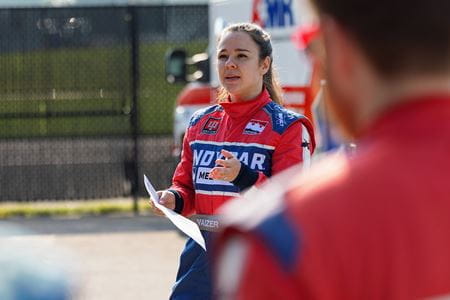 McCarthy, the program’s previous fellow, came to IU with a military and engineering background and took an interest in improving cars for driver safety. After completing her fellowship in 2023, she stayed on as an INDYCAR physician and consultant with the Driver Safety and Incident Investigation Team.
McCarthy, the program’s previous fellow, came to IU with a military and engineering background and took an interest in improving cars for driver safety. After completing her fellowship in 2023, she stayed on as an INDYCAR physician and consultant with the Driver Safety and Incident Investigation Team.
“This season, we’re looking at improving seats to help avoid spinal fractures,” McCarthy said. “We literally pick apart every single accident that happens, especially if the driver gets hurt, and figure out what we can do to improve the car to make sure no one else gets hurt in the same type of accident in the future.”
As the field of motorsports medicine continues to develop, Vaizer sees IU’s fellows as “bricks” in the foundation of this emerging, high-action medical specialty.
“IU is the model program for expanding motorsports medicine training across the U.S.,” she said.
